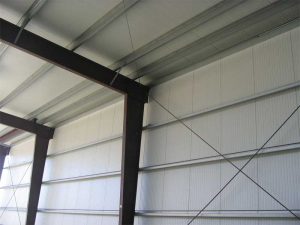by Geremy Mendelson, CDT

Metal walls are commonly used on commercial, industrial, education, and residential projects for many reasons. Metal can be formed into several shapes, sizes, colors, and textures to meet almost any aesthetic. If specified correctly, the assembly will last for the life of the building with very few issues.
A rainscreen system consists of four components—an air and water barrier, continuous exterior insulation, framing, and exterior cladding. The rainscreen system should be able to adapt to the project’s hygrothermal region by allowing several options of permeability in the vapor barrier and thickness of the continuous insulation (ci). A rainscreen system allows a certain percentage of moisture to penetrate the façade. The moisture is then managed by the framing, insulation, and air/water barrier. To comprehend how the system works, one needs to understand each of the four layers and their options.
Air and water barriers
Air and water barriers (A/WB) are often the vapor barrier as well. Permeability is an important factor in very warm or cold environments because of the accumulation of excess vapor in a space. Allowing the vapor to move to the exterior of the A/WB is key to eliminating mold and mildew. This is especially important in projects with excess humidity, such as indoor pools, gyms, locker rooms, and performing arts centers.

Photo courtesy All Weather Insulated Panels
There are three established levels of permeability:
- impermeable, which allows less than or equal to 1 US perm;
- semi-permeable (1 to 10 US perms); and
- permeable (greater than 10 US perms).
Vapor barriers can be fluid-applied, self-adhered, or mechanically attached. They are available in many permeability levels.
Insulation
Continuous exterior insulation is not only required by code, but it also improves the building’s overall performance. Continuous insulation can be made of expanded polystyrene (EPS) with R-4 per inch, extruded polystyrene (XPS) with R-5 per inch, polyisocyanurate (ISO) with R-6.5 per inch, or mineral wool with R-4 per inch. There are open- and closed-cell foams. Open-cell (90 percent open) will hold water. Closed-cell (10 percent open) will do much better, but will not hold up under extreme moisture conditions. All types of foam insulation expand and contract with heat and cold. EPS and XPS are the least expensive. Mineral wool and ISO are about the same cost
per cubic foot.
Framing
The sub-framing of a rainscreen assembly can affect the strength and stability as well as its thermal performance. Z-, C-, and L-clips are all attached to the metal studs of the building. The rigid insulation is held between these clips with construction adhesive. Hat channels sit on top of insulation with screws going through the rigid material and into the studs of the building, thereby improving thermal performance.




